Our editors independently select these products. Making a purchase through our links may earn Well+Good a commission
A Definitive Roundup of the 6 Most Delicious, Nutrient-Rich Vegan Mac-and-Cheeses, According to RDs
Two registered dietitians compare the most popular vegan mac-and-cheese brands and reveal their hands down absolute favorite.
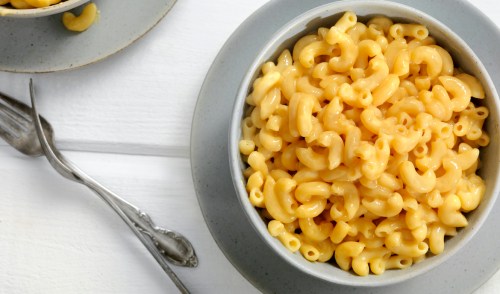
A big bowl of mac-and-cheese is pure comfort food, whether you’re five or 95. But, like a lot of foods that may have been part of your childhood, mac-and-cheese in 2021 looks a little different than it used to.
Experts in This Article
registered dietitian
plant-based registered dietitian nutritionist and NASM-certified personal trainer
Now, you can choose between traditional wheat noodles or ones made of chickpeas, lentils, or brown rice pasta. As for that pale orange powder that magically turns into cheese? The ingredients look a lot different for that, too. In years of mac-and-cheese past, the powder was made with whey, milk protein concentrate, milk fat, and cheese culture—not exactly a welcome list if you’re vegan or dairy-free. (Then, it was typically mixed with milk because once upon a time alternative milks were not a Thing.) These days, if you want a vegan mac-and-cheese, you have options, so many in fact that it can be hard to figure out which one to add to your cart.
Even Trader Joe’s came out with their own vegan mac, made primarily with wheat noodles, butternut squash, coconut milk, dairy-free butter, and nutritional yeast. Sounds amazing, right?
As with any food, taste is absolutely important when choosing a vegan mac-and-cheese. Comfort food isn’t exactly comforting if it doesn’t taste good. While it may take some taste testing to figure out what brand you like best (tough job, right?), comparing between them nutritionally is more concrete. For that, registered dietitians Whitney English Tabaie MS, RDN, author of The Plant-Based Baby and Toddler ($20), and Amanda Baker Lemein, MS, RD, are happy to provide their inputs—starting with the Trader Joe’s mac. “The butternut squash likely lends some color while the nutritional yeast offers that cheesy flavor we all love,” Lemein says. Tabaie is into butternut squash being used too, but says coconut milk is high in saturated fat, so she prefers a nut-based sauce. What about all the other vegan mac-and-cheese options? How do they stack up nutritionally? Let’s get into it.
The 6 best vegan mac-and-cheeses (in no particular order)
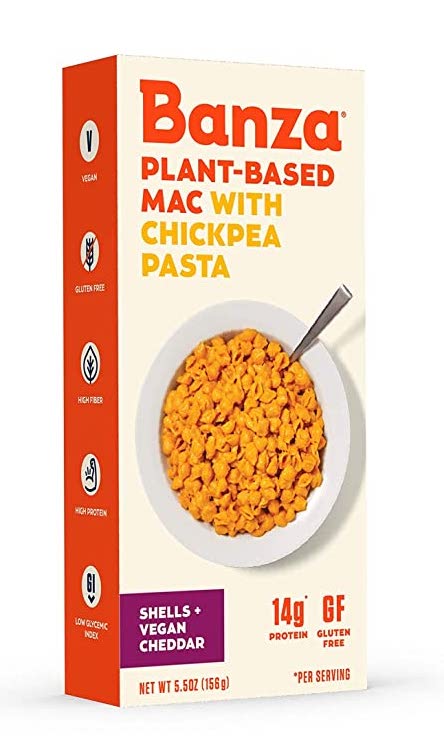
Banza Plant-Based Mac with Chickpea Pasta — $4.00
What’s in it: (In the pasta): Chickpeas, pea starch, tapioca, xanthan gum; (In the vegan cheese): sweet potato, coconut oil powder, nutritional yeast, sea salt, pumpkin, tapioca, annatto extract, turmeric extract, paprika extract, lactic acid, citric acid, paprika, xanthan gum, organic natural flavor, onion, garlic
What RDs think: Tabaie says this one is hands-down her favorite. “I’m a big fan of legume pasta. Not only is it packed with protein and fiber, but it also has a good deal of minerals like iron and zinc as well,” she says. She also loves that veggies like sweet potato and pumpkin pop up on the ingredients list and that anti-inflammatory herbs turmeric and paprika are used for color. In her opinion, this mac-and-cheese only has positives, no negatives!
Lemein whole heartedly agrees. “Chickpea-based pasta is going to have a higher fiber and protein content than traditional wheat pastas. The ingredients are a pretty straightforward vegan list with certain oils and gums to help with the mouthfeel,” she says. But she adds that the texture of chickpea noodles *is* different than ones made of wheat. That means, not everyone may be a fan. However, on the nutrition side, this pick gets an A+.
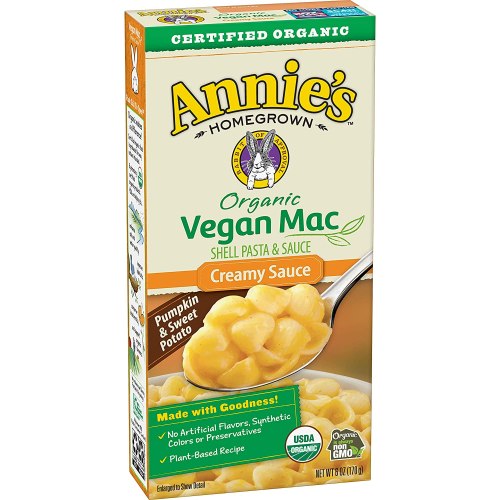
Annie's Organic Vegan Mac — $4.00
What’s in it: (In the noodles): Wheat flour; (In the vegan cheese sauce): pumpkin powder, sweet potato powder, maltodextrin, corn starch, tapioca starch, sea salt, natural flavor, paprika, onion powder, garlic powder
What RDs think: While the Banza mac-and-cheese has Tabaie’s heart, Lemein says this one from Annie’s is her favorite. “I like the flavor and texture, and nutritionally, I like that it has minimal saturated fat while still being fairly high in protein at eight grams per serving,” she says. She also points out that it’s certified organic, another plus.
Tabaie though, isn’t *as* excited about it. “It’s similar to Howl and Upton’s, but it’s lower in fiber and higher in sodium, so it’s lower on my list,” she says. But she adds that there’s nothing in it that’s particularly alarming either.

Hoawl Mac & Chef — $8.00
What’s in it: (In the noodles): Wheat semolina; (In the vegan cheese sauce): water, cashews, nutritional yeast, salt, lemon juice, corn starch, vegan lactic acid, organic gum acacia, organic guar gum, xanthan gum, garlic
What RDs think: Cashews (the primary ingredient in this mac’s sauce) are a go-to plant-based ingredient for making rich, creamy sauces. That means this pick is bound to be velvety. “The nutritional yeast will offer a cheesy flavor while the cashews add a richer mouthfeel and help with the protein boost here, too,” Lemein says of it.
Tabaie says she’s into it too because cashews are not just a good source of protein, but also healthy fats. It also means it will actually fill you up, too. As long as you don’t have a problem with gluten, there’s no downsides to this pick.

Upton's Ch'eesy Mac — $6.00
What’s in it: (In the noodles): Durum wheat semolina; (In the vegan cheese sauce): nutritional yeast, rice bran oil, sea salt, corn starch, mustard, onion, garlic, paprika, turmeric, sugar.
What RDs think: Similar to the Howl mac, this one from Upton’s is made with traditional wheat noodles—only an issue for people who are gluten-free. As for the sauce, while it isn’t exactly full of nutritional benefits, there are no red flags either. “While there are many spices, the main factor in this sauce comes from the rice bran oil—just another fat source to offer a heavier mouthfeel more similar to regular cheese,” Lemein says.
“This one is very similar to Howl,” Tabaie says. “It’s a good source of protein and fiber, and low in saturated fat.” But since it doesn’t have the protein-rich nuts that Howl has, she ranks it a bit lower on her list, nutritionally.
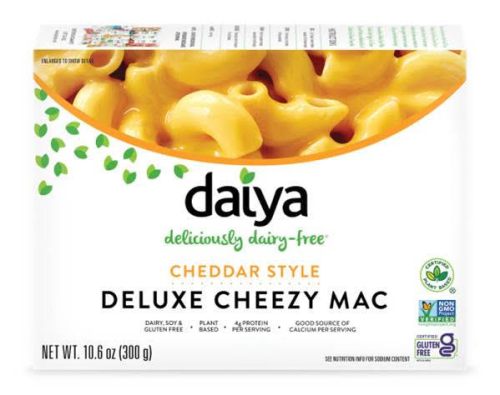
Daiya Deluxe Cheezy Mac — $8.00
What’s in it: (In the noodles): Brown rice pasta; (In the vegan cheese sauce): filtered water, tapioca starch, non-GMO expeller pressed canola oil and/or saffron oil, coconut oil, sea salt, vegan natural flavors, pea protein isolate, tricalcium phosphate, can sugar, lactic acid, xanthan gum, yeast extract, titanium dioxide, annatto, onion
What RDs think: Daiya is one of the leaders in the dairy-free space, so it’s no surprise they have a vegan mac on the market. Brown rice pasta is used for the noodles which Lemein says is nutritionally comparable to wheat pasta; both have similar amounts of fiber. She does point out that this pick is the highest in saturated fat and the lowest in protein, making it nutritionally weaker compared to the others.
Still, there are positives worth highlighting. “While this one is lower in protein and fiber, it is free from all allergens and therefore is a good option for children with food allergies,” Tabaie says.
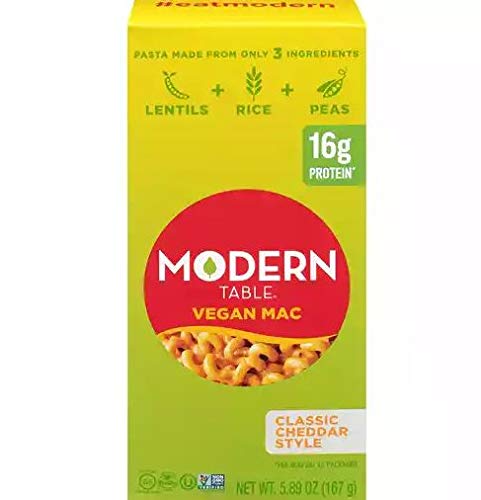
Modern Table Vegan Mac — $4.00
What’s in it: (In the noodles): Red lentil flour, white rice, pea protein; (In the vegan cheese): palm oil powder, rice syrup, salt, modified food starch, natural flavors, lactic acid powder, sunflower lecithin, annatto extract, paprika extract
What RDs think: Both dietitians like that this mac-and-cheese is made with legumes (in this case red lentil flour), which is higher in fiber and protein than traditional wheat noodles. Additionally, the pea protein ups the protein even more. But Tabaie says she isn’t a huge fan of the white rice, which she says isn’t as nutrient-rich as using just legumes would be.
As for the sauce, both RDs say there aren’t any major issues, but Tabaie says palm oil (a primary ingredient) should be consumed in moderation because it’s a saturated fat (not great for heart health) and often isn’t soured sustainably. But in general, if this is the one you like the taste of the best, both RDs say to go for it.
Again, with all foods—but especially comfort food—taste is paramount. “The nutritional differences between the products are minimal, so just go with the one you like the most and pair it with complimentary nutrient-dense foods like fruits and vegetables,” Tabaie says. You can always personalize your bowl, adding in veggies from your crisper. Sometimes, you have to think outside the box to get the best end result.
Oh hi! You look like someone who loves free workouts, discounts for cutting-edge wellness brands, and exclusive Well+Good content. Sign up for Well+, our online community of wellness insiders, and unlock your rewards instantly.
Sign up for the Well+Good SHOP Newsletter
Get exclusive deals on wellness, beauty, fitness, and food products that have been hand-picked by our editors.
Got it, you've been added to our email list.









